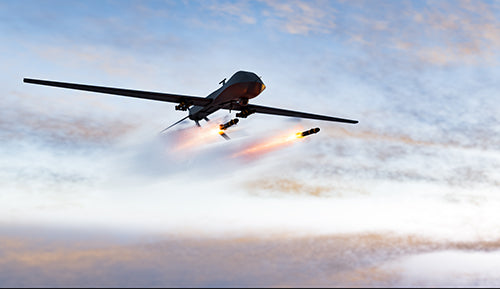
Intelligent surveillance: AI analyzes sensor data
to identify threats, track targets, and provide
real-time situational awareness.
By Martin Stiborski, Managing Director, BRESSNER Technology
The integration of Artificial Intelligence (AI) into warfare has revolutionized the technological landscape of modern military operations. AI-driven systems are capable of autonomously processing data, making intelligent decisions, and executing complex tasks with precision. In this blog article, we provide a comprehensive overview of the current capabilities of AI in warfare, explore future possibilities, and examine the challenges faced by the underlying hardware.
Challenges for Deployed Hardware
|
 Autonomous weapons: AI-driven drones and |
AI has transformed warfare through intelligent decision-making, autonomous systems, and advanced data analysis. The current capabilities of AI in warfare are already significant, and the future possibilities are both promising and challenging. Overcoming hardware-related obstacles such as computational power, robustness, and cybersecurity is crucial to fully harness the potential of AI in warfare. With advancing technology, responsible development, rigorous testing, and consideration of ethical aspects are essential to ensure the effective and ethical use of AI in military operations.
Click the buttons below to share this blog post!

By: Jaan Mannik – Director of Commercial Sales
The term AI, or Artificial Intelligence, is everywhere nowadays and has quietly woven itself into the fabric of our daily lives. It powers the recommendations we see on streaming platforms, the navigation apps that guide us through traffic, and even the virtual assistants that answer our questions in seconds. From optimizing energy use in smart homes to predicting market shifts in finance, AI has become the invisible engine driving convenience, efficiency, and insight across industries.
In manufacturing, AI-driven robots collaborate with humans to streamline production. In agriculture, machine learning models monitor crops, forecast yields, and conserve resources. Retailers use predictive analytics to anticipate consumer needs before customers even express them. The reach of AI is no longer confined to futuristic labs, it’s in our phones, vehicles, and cities, constantly learning and adapting to serve us better.

OSS PCIe-based products deliver critical advantages for modern military sensor systems by enabling real-time data acquisition, processing, and transmission in rugged, mission-critical environments. These benefits stem from their ability to support high-bandwidth, low-latency interconnects, modular scalability, and environmental resilience, all of which are essential for today’s advanced military platforms.

Companies today are being asked to do more with data than ever before. Bigger AI models, faster insights, and workloads that don’t stay in one place, it’s a lot to keep up with. Traditional infrastructure just isn’t built for this kind of speed and flexibility.
The answer isn’t about throwing more hardware at the problem. It’s about building smarter, more agile infrastructure that adapts as demands change. And that’s where scale-out and increasingly, a blend of scale-out and scale-up come into play.